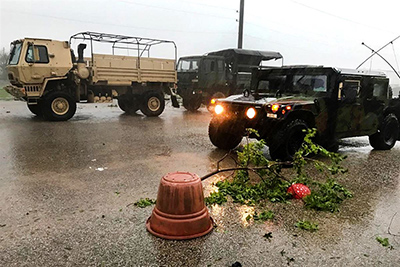Although it may be too early to collect any data from this second major hurricane in three weeks, Noel Perry, Partner at FTR and Senior Economist for Truckstop.com says the impact will be significant.
Noel told an audience gathered for the 2017 FTR Transportation Conference this week that Hurricane Harvey provided some understanding for what Irma might do.
Like Harvey, Irma is primarily a water event, noted Noel in his initial assessment. Even though the Florida Keys and southwestern Florida got some big winds. With Harvey the wet came from the skies, with Irma more of it is coming as storm surge from the ocean. That comes from the fact that Irma will affect more than twice the coastline touched by Harvey.
In addition, Harvey was a smaller storm. That became a big deal when it stalled right over Houston, setting the contiguous U.S. record for sustained rainfall. Once it hit Florida, Irma speeded up its movement and will have died out in Indiana, a thousand miles from Key West in the time that Harvey squatted over Houston. That means Irma's effects may be less catastrophic in any one place but will visit many more places.
One other difference is that Houston is a major manufacturing town, with the chemical plants right down on the water. In Florida, it's mainly consumer activity. So, the effects in Texas will be heavily tank truck and railcar related, while in Florida it will be dry vans full of consumer goods and flatbeds full of wall board.
Together Florida and Texas represent about 15% of the U.S. economy. The storm interruptions of those two economic engines, 4th and 2nd respectively among the states, will cost U.S. GDP about .5% in the third quarter of 2017.The two states account for about seven percent of U.S. trucking activity on a typical day and affect another four percent as important parts of truck trip circuits.
Using Harvey as a guide, this week will be a major down week for trucking in the Southeast, with volumes off perhaps 25%. Inbound to Florida, a headhaul in the best of time will probably demand a premium, with prices up 10% to 30% depending on the lane. Prices may fall outbound. Volume should get back to normal during the second week, at least inbound, then run modestly higher for six months or more.
SC
MR


Latest Supply Chain News
- AI, virtual reality is bringing experiential learning into the modern age
- Humanoid robots’ place in an intralogistics smart robot strategy
- Tips for CIOs to overcome technology talent acquisition troubles
- There is still work to do to achieve supply chain stability
- Blooming success: The vital role of S&OE in nurturing global supply chains
- More News
Latest Resources

 Explore
Explore
Business Management News
- AI, virtual reality is bringing experiential learning into the modern age
- Tips for CIOs to overcome technology talent acquisition troubles
- There is still work to do to achieve supply chain stability
- Blooming success: The vital role of S&OE in nurturing global supply chains
- Supply chain salaries, job satisfaction on the rise
- How one small part held up shipments of thousands of autos
- More Business Management
Latest Business Management Resources

Subscribe

Supply Chain Management Review delivers the best industry content.

Editors’ Picks





